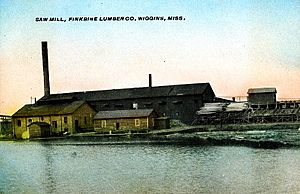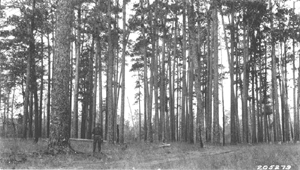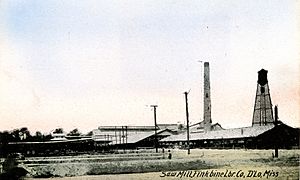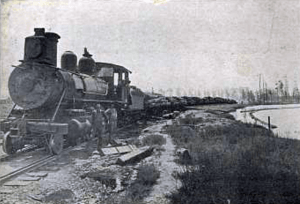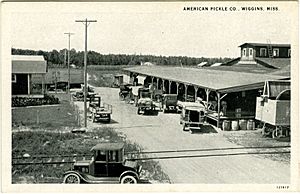Finkbine-Guild Lumber Company facts for kids

Finkbine Lumber Company letterhead (1907)
|
|
| Successor | Wilbe Lumber Company |
|---|---|
| Founded | 1901 |
| Founder | W.O. Finkbine, E.C. Finkbine, W.E. Guild |
| Defunct | 1927 |
| Headquarters | Wiggins, Mississippi Jackson, Mississippi |
| Products | Longleaf pine |
| Subsidiaries | Mississippi Farms Company American Pickle and Canning Company |
The Finkbine-Guild Lumber Company was a big business that cut down and sold longleaf pine trees in southern Mississippi. This happened in the early 1900s. Their main sawmills, which are factories that cut logs into lumber, were in Wiggins and D'Lo, Mississippi.
When they ran out of local trees, the company tried to bring redwood trees from California. But this didn't work well because it cost too much to move the logs. The company also tried other ways to use the land after the trees were cut down. Some of these ideas worked, and some didn't.
Contents
History of the Lumber Company
The Amazing Longleaf Pine Trees
Before the 1900s, the huge pine forests in south Mississippi were mostly untouched. This was because there was no easy way to get the cut logs from the forests to the sawmills.
There was a massive area of longleaf pine trees. It stretched from Virginia all the way to east Texas. This huge forest covered more than 140,000 square miles (363,000 square kilometers). Longleaf pine was very important to lumber companies in the southern U.S.. This was because the trees grew straight and were very strong due to their high resin content.
Railroads Change Everything
A few sawmills were built along the Mississippi Gulf Coast. They were close to rivers and streams, which were used to float logs to the mills. But because there weren't many waterways going inland, most of the huge forests couldn't be reached by lumber companies.
This changed in the late 1800s when the Gulf and Ship Island Railroad (G&SIRR) was built. The main railway line was 160 miles (257 kilometers) long. It went from Gulfport, north to Jackson, the state capital.
The G&SIRR started running from Gulfport to Hattiesburg in 1897. The part from Hattiesburg to Jackson opened in 1900. The railroad passed through Wiggins, which was halfway between Gulfport and Hattiesburg. Because of the growing timber business, Wiggins became a busy sawmill town.
Starting and Growing the Company
Two very rich businessmen, W.O. and E.C. Finkbine, came from Des Moines, Iowa. They found out about the valuable timber, minerals, sand, and gravel in northern Harrison County (now Stone County). They already owned a lumber company and lumberyards in Iowa. They also had a large wheat farm in Canada. But the main reason they came to Mississippi was the huge amount of untouched southern yellow pine trees.
The leaders of the Finkbine Lumber Company were E. C. Finkbine (president), W. O. Finkbine (vice president), and W. E. Guild (treasurer). In 1901, they bought two sawmills in Wiggins, Mississippi. These mills belonged to the Niles City Lumber Company. In 1903, W. E. Guild became the general manager of the Wiggins sawmills. The Finkbine Lumber Company also bought all of Niles City Lumber Company's timberlands. In Stone County alone, the Finkbine Lumber Company owned about 25,000 acres (10,000 hectares) of timberland.
In 1903, the Finkbine Lumber Company finished building a new, big sawmill in Wiggins. This new mill could produce 125,000 board feet of lumber every day. It had five dry kilns (ovens to dry wood), a large planing mill, and a shed to store the finished lumber. The mill cut longleaf pine logs into different sizes for building. The Finkbine Lumber Company sold lumber both in the U.S. and to other countries. The port in Gulfport, Mississippi, was used for shipping lumber overseas.
A large company store was built in Wiggins to help the Finkbine business. This store was called the Kew Mercantile Company. It served the Finkbine Lumber Company employees and everyone else in the community.
In 1914, the company created the town of Finkbine. It was west of Johns in southern Rankin County, Mississippi. This town had a school, church, YMCA, barber shop, post office, and doctor's office. Finkbine was a "company town" for workers from 1919-1920. It was then moved closer to the company's operations and stayed there until the company stopped working in 1927.
The Company's Busiest Years
At some point, the company's name changed to Finkbine-Guild Lumber Company. In 1915, Finkbine-Guild started building a new, all-electric sawmill in D'Lo, in Simpson County, Mississippi. When it opened in 1916, the D'Lo sawmill could cut 200,000 board feet of lumber every 10 hours. The logs for the D'Lo sawmill came from Simpson, Rankin, Smith, and Scott counties in Mississippi. In 1918, Finkbine-Guild moved its main offices from Wiggins to Jackson, Mississippi.
To make it easier to cut down trees, Finkbine-Guild Lumber Company built its own special rail lines. These were often called "dummy lines" and went right into their forests. One of their forest railroads went 24 miles (39 kilometers) southeast from Wiggins. The company used a special steam machine called a skidder. This machine could pull all the logs from 4 acres (1.6 hectares) at one time. Each pull could bring 5 to 15 logs to the dummy rail line for loading onto trains. When they were busiest, Finkbine-Guild used 5 locomotives (train engines) out of Wiggins and D'Lo. However, using these steam skidders completely destroyed young trees, leaving the land bare.
The California Experiment
As their forests in Mississippi were running out of trees, the Finkbine-Guild Lumber Company came up with a new idea. They planned to use their Mississippi mills to finish processing redwood timber from California. In 1925, Finkbine-Guild bought the Cottoneva Lumber Company in Rockport, California, near the Pacific Ocean.
Because Rockport was in a remote area, Finkbine-Guild had to build houses, a company store, dining halls, a school, a hotel, a barber shop, and a hospital. The company also built a sawmill, logging railroads, and a steam-powered cable system. This system was used to move logs from the shore to ships. The Rockport mill only produced "cants." These were squared-off logs that were shipped to the Mississippi mills for final cutting.
In San Francisco Bay, near Sausalito, California, Finkbine-Guild spent a lot of money building a dock and loading area. The company owned five ships that burned oil for fuel. They called this group of ships "The Redwood Line." These ships carried the logs from San Francisco Bay, through the Panama Canal, to Gulfport, Mississippi. The logs were unloaded at Gulfport and put onto railroad flatcars. Then, they were transported north to the Finkbine mills in Wiggins or D'Lo. There, the redwood was cut into finished lumber.
Many problems made it hard for the company at the Rockport facility. They had broken machines, broken cable lines, bad weather, blocked roads, trouble getting supplies, and issues with workers. Because of all these problems, the Finkbine-Guild Lumber Company stopped its California operations after only two years. In 1928, all the land Finkbine-Guild owned in California was sold to the Southern Redwood Company. The Finkbine-Guild experiment in California failed because the company had extra costs to transport logs all the way to Mississippi. Other redwood companies processed their timber closer to where it was cut.
New Ideas for the Land
By 1927, most of the original pine trees in Mississippi were gone. Also, no more redwood logs were being shipped to the Mississippi sawmills. On July 1, 1929, the Finkbine-Guild sawmills and the remaining timberlands in Wiggins and D'Lo were sold to the Wilbe Lumber Company.
To try and sell their cut-over timberland in south Mississippi, Finkbine-Guild Lumber Company started the Mississippi Farms Company. The Farms Company advertised the land for sale to encourage people from northern U.S. states, like Slavs and Poles, to move to Mississippi. They hoped these families would buy land along the old Finkbine-Guild logging roads. However, clearing the land of tree stumps and trying to grow crops in the thin soil was very hard work. Many farms failed during the long, hot summers.
One successful idea from Finkbine-Guild and Mississippi Farms Company was building a factory in Wiggins. This factory processed farm produce. The American Pickle and Canning Company was created to run what became known as the 'pickle factory'. At first, the factory processed pickles, tomatoes, beans, and sweet potatoes. But within a few years, pickles became its only product. At one time, it was the largest pickle processing plant in the world! Over time, the pickle factory changed owners. It became part of Brown-Miller Company, then Beatrice Foods. These larger food companies moved their production to other U.S. states. The Wiggins pickle factory closed in 1983, which was the end of the Finkbine-Guild era.
Images for kids


